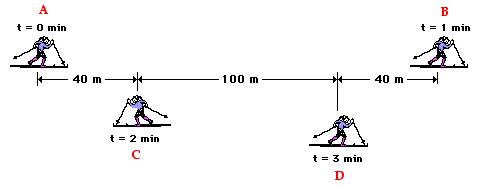Thursday, October 28, 2010
Examples and Answers
Interpreting Graphs 1 and drawing a graph from a "story!"
Example of graphing Distance (vs) Time
7th graders demonstrate inertia and motion.
A great review of Acceleration!! (and Newton)
Comments box is open...
Did you get these answers ?
Wednesday, October 27, 2010
Goldilocks and Coral. hmmmm?
Rick MacPherson writes in Coral and the Goldilocks Effect:

For as much as I love coral reefs, I've gotta admit that coral polyps are the prima donnas of the ocean. Most coral reefs are located between the tropics of Cancer and Capricorn--not much more than 30 degrees north and south of the equator. Not too far north nor too far south, but just right. Corals are also found farther from the equator in places where warm currents flow out of the tropics, such as Florida and southern Japan. Reef building corals grow best in waters with a temperature of between 21 and 29 degrees Celsius (70 and 85 degrees Fahrenheit). It is possible for soft corals to grow in hotter and colder places, but growth rates under these conditions are very slow. Again, they like it just right.
Tropical coral species are particularly fussy about temperature. As I've described before, when sea surface temperatures start to climb more than 2-4 degrees Celsius for an extended period of time, coral polyps get stressed and can expel their algal symbionts. Once the algae (zooxanthellae) are evicted, the translucent coral polyp appears white (or bleached). If temperatures remain elevated and the coral cannot reacquire new heat-tolerant algae, the coral may die.
But bleaching can result not just when conditions are too warm, but also when conditions are too cold. Some recent news from Heron Island on Australia's Great Barrier Reef describes how unusually cold weather has resulted in a winter bleaching event. Just the other day I described how the relatively rare phenomenon of sun-dried tides can cause mass coral bleaching and mortality. In a twist on that theme, if unusually low tides are coupled with chilly, windy (conditions that are just wrong for coral) a similar mass mortality can result. These images of bleaching are courtesy of Ove Hoegh-Guldberg's fantastic website Climate Shifts.

- Where do coral reefs grow?
Coral reefs can be seen throughout the tropical and subtropical Western Atlantic and Indo-Pacific oceans, generally within 30 degrees N and 30 degrees S latitudes.
- Why do you think that coral reefs only occur between certain latitudes, and then only within certain areas?
Studies have shown that most reefs grow well between the temperatures of 23-25 degrees C. The temperature is ideal year round in these locations, not too hot, and not too cold.
- What major factors limit where coral reefs can found? List 5 major factors limiting the occurrence of coral reefs and describe HOW these factors limit the establishment or success of coral.
| Factor | Requirements | Why is it important? | |
| | Temperature | 18-30 C (64-86 F) | Stable temperature between 18-30 C is necessary for the survival of coral reefs. |
| Salinity | 33 - 36 parts per thousand | ||
| Light | The maximum depth for actively growing coral is 70m | The need for light for coral reefs� symbiotic plant is thought to limit reefs building corals to shallow water. | |
| Wave action | Reef development is generally more abundant in area that is subject to strong wave action. | Waves carry food, nutrients, and oxygen to the reef.� Waves distribute coral larvae.� Waves prevent sediment from settling on the coral reefs. |
Corals historically thrived in clear water, but recent bleaching events have revealed that water can be too clear! Corals need some nutrients and plankton for food, but not enough to promote algal overgrowth and rapid bioerosion rates.
The corals of the Florida reef tract provide clues to how “Goldilocks” these reef builders can be. The offshore reefs, where waters are clearest, have declined dramatically over the past several decades such that coral cover is now too low to sustain reef accretion. Only on patch reefs is coral cover at least in double-digit percentages.
Hallock, Pamela. " Goldilocks and the Three Biogenic Carbonate Minerals: What Determines “Just Right”?. College of Marine Science, University of South Florida
There is a greater variety of species in, on and around coral reef than anywhere else in the ocean. This is a link to Florida Coral Reefs
What would you do ? This is a "REAL LIFE " interactive about coral. Make decisions by yourself or with classmates
The Comment/Bonus box is open...
What do you know now?
What would you like to know more about?
How will you find out?
Monday, October 25, 2010
Coral Legacy
" There has long been a belief that the sea, at least, was inviolate, beyond man's ability to change and to despoil. But this belief, unfortunately, has proved to be naive. "
--Rachel Carson

How much do you know about coral?
Try a Worldwatch quiz or Ocean world - I like this one
What is coral? When you see pictures in National Geographic of huge rock like things in the ocean with fish swimming all around, is that coral? Well, sort of. That is a coral reef.
Take a Live FISH EYE VIEW.... look for yourself...
©1995 -2010 Quantum Leap Network, Inc. - All Rights Reserved
Coral is an animal that belongs to the phylum cnidaria. A phylum is a group that scientists place animals in which share certain characteristics. Cnidarians are radially symmetric, which means that they are the same all the way around, 360 degrees! They are built like sacs with a hole in one end that is surrounde
d by stinging tentacles. Jellyfish are cnidaria. Now, you are probably thinking, jellyfish don't look anything like what I thought coral was! That's because the most common pictures of coral are colonies called reefs.
During the mating season coral polyp release eggs and sperm into the water (picture below) and when an egg and a sperm meet they form a larva known as a planula.
Mountainous star coral (Montastraea faveolata) in the process of releasingboth eggs and sperm.
Click here for a larger view!
The baby coral looks like a little tiny jellyfish and it floats around in the water until it finds a hard place to attach to, usually a coral reef. Then it lands and starts to build itself a shell. It builds it by combining carbon dioxide (CO2) and calcium (Ca) in the water to make calcium carbonate (CaCO3) also known as limestone. This shell is shaped like a round vase and the coral polyp lives inside.
Coral Polyp
(Photo courtesy Jeffrey N. Jeffords)
Coral polyps are primarily nocturnal. At night a coral polyp will stick its tentacles out of its vase and let the tentacles wave in the current. Then, when plankton float by, the coral polyp stings them with its tentacles and brings the plankton inside its shell to have for lunch.
A coral reef is about a million of these individual coral polyp shells all stuck one on top of the other. When coral polyps die, new ones land and grow right on top of the old empty shells. There are over 500 different species of coral. Some look like brains and some like fans and some like the antlers of deer, but they are all made up of tiny coral polyps.
Organisms other than coral can form reefs. A reef is simply a structure in the shallow parts of the ocean that serves as a home to animals and plants. Many sunken ships have become reefs and humans even create artificial reefs to replace the coral reefs that we have destroyed. Some artificial reefs are specially constructed for the purpose, but others are made of tires linked together, old appliances linked together and even discarded military equipment like tanks and helicopters.
You can dive to greater depths in this adventure in the Coral Realm
Coral Reefs are often called : The Rainforests of the Sea ?
Can you explain what might make people say this? (Bonus points available)
The comment box is open
Sunday, October 10, 2010
Eureka Moments
EUREKA !!
Scientists from Ancient Greece - Did some REALLY COOL STUFF
Thales and some others - who may have started it all
And FAMOUS SCIENTISTS different lists and ways to search ...
How is this or how are they important to us today? What could we possibly have in common?
Well, For example: We are studying MOTION. 2500 years people were too...
Strato (who died around 268 B.C., he is sometimes called Straton) did. he observed much more carefully than Aristotle, and realized that falling bodies usually accelerate. He made two important points: rainwater pouring off a corner of a roof is clearly moving faster when it hits the ground than it was when it left the roof, because a continuous stream can be seen to break into drops which then become spread further apart as they fall towards the ground.
Famous in the history of "Discovery" is Archimedes' shout... EUREKA!! .. truth or fable?
We are not certain,... but the math is proven!
We still use the word today.... ( and the math!)
We call them “Eureka” moments, sparks or breakthroughs, and we say things like “The lightbulb just went on.” We talk about good ideas as if they burst forth in one instant, and in one mind. But what if ideas are actually the works of hunches cobbled together and incubated over time?
This is how author Steven Johnson talks about ideas. He rejects the history books that tell romantic stories of inventors working alone in a laboratory, and instead presents stories of collaboration — of “ideas built on top of other ideas.”
In his book Where Good Ideas Come From: The Natural History of Innovation, Mr. Johnson traces seven centuries of innovation and argues that these tales of invention — a swath that takes in everything from the printing press to the Internet, the pencil to the flush toilet and an incubator made entirely from car parts — prove that an “idea is not a single thing, it is more like a swarm.”
“Ideas are growths of other peoples’ hunches,” Mr. Johnson said.
Read more: http://www.nationalpost.com/news/canada/Eureka+moments+really+come+flash/3646918/story.html#ixzz11yLZQ4bLStudents should read about the phenomenon that was studied, how the experimental apparatus was configured, what was done with the findings, what specific errors and corrections were made, where ideas came from, and how the scientist’s colleagues, the public, the press, the government, or the funders reacted to the work. Students should be aware that scientists
encounter obstacles and experience setbacks as well as successes. Students should consider books that describe the work done by men and women in different areas of science, from various cultures, and who lived in different time periods.
Here is a great site to get one started searching for Great Women in Science... (yes, it is OK to play the games while you are at it)

The Web site iWASwondering.org is inspired by Women's Adventures in Science, a biography series for middle-school-aged students co-published by the Joseph Henry Press and Scholastic Library Publishing. Women's Adventures in Science chronicles the lives of contemporary, working scientists. Despite thei
....Many have made great sacrifices... often breaking social barriers along the way..
Scientists change and improve how we understand the universe... Sir Isaac for example..
Other links for scientists
Famous Scientists and a Time Line of Scientists, a TOP TEN LIST you might even find a video of your scientist here on "BIOGRAPHY"
Here is a site that was put together by another student working on the same project
Sizzling Smart Scientists .
Don't forget your textbooks may provide examples too!
| |||||
| |||||
the Comments box is open...
What have you discovered?
Have you ever had a EUREKA moment?
Who interests you most?
Wednesday, October 6, 2010
The Mangrove Connection
MAN OH MAN OH Mangroves

Red Red roots

Black pirate fingers
Two bumps on the side

Red Red pointy head


Black Black Salt on back

White White no roots in sight.
Tuesday, October 5, 2010
Motion
Speed and Velocity
Just as distance and displacement have distinctly different meanings (despite their similarities), so do speed and velocity. Speed is a scalar quantity that refers to "how fast an object is moving."
Speed can be thought of as the rate at which an object covers distance. A fast-moving object has a high speed and covers a relatively large distance in a short amount of time. A slow-moving object has a low speed and covers a relatively small amount of distance in a short amount of time. An object with no movement at all has a zero speed.
Velocity is a vector quantity that refers to "the rate at which an object changes its position." Imagine a person moving rapidly - one step forward and one step back - always returning to the original starting position. While this might result in a frenzy of activity, it would result in a zero velocity.
Because the person always returns to the original position, the motion would never result in a change in position. Since velocity is defined as the rate at which the position changes, this motion results in zero velocity.
If a person in motion wishes to maximize their velocity, then that person must make every effort to maximize the amount that they are displaced from their original position. Every step must go into moving that person further from where he or she started. For certain, the person should never change directions and begin to return to the starting position.
Calculating Average Speed and Average Velocity
The average speed during the course of a motion is often computed using the following formula:
In contrast, the average velocity is often computed using this formula
Let's begin implementing our understanding of these formulas with the following problem:
Q: While on vacation, Lisa Carr traveled a total distance of 440 miles. Her trip took 8 hours. What was her average speed?
To compute her average speed, we simply divide the distance of travel by the time of travel.
That was easy! Lisa Carr averaged a speed of 55 miles per hour.
She maynot have been traveling at a constant speed of 55 mi/hr. She undoubtedly, was stopped at some instant in time (perhaps for a bathroom break or for lunch) and she probably was going 65 mi/hr at other instants in time. Yet, she averaged a speed of 55 miles per hour. The above formula represents a shortcut method of determining the average speed of an object.
And now a little Acceleration....A SPEEDY REMINDER...
According to Newton's first law, an object in motion continues in motion with the same speed and in the same direction unless acted upon by an unbalanced force. It is the natural tendency of objects to keep on doing what they're doing. All objects resist changes in their state of motion. In the absence of an unbalanced force, an object in motion will maintain its state of motion. This is often called the law of inertia.
So speed and velocity are governed by laws..
If the car were to abruptly stop and the seat belts were not being worn, then the passengers in motion would continue in motion. Assuming a negligible amount of friction between the passengers and the seats, the passengers would likely be propelled from the car and be hurled into the air. Once they leave the car, the passengers becomes projectiles and continue in projectile-like motion.
Now perhaps you will be convince of the need to wear your seat belt. Remember it's the law - the law of inertia.
Thanks to, © 1996-2010 The Physics Classroom
Can you do this one?
The diagram below shows the position of a cross-country skier at various times. At each of the indicated times, the skier turns around and reverses the direction of travel. In other words, the skier moves from A to B to C to D.Use the diagram to determine the average speed and the average velocity of the skier during these three minutes.

Show your work and explain your answer for Bonus!
Comments box is open..
What do you think of this post?
Did it help?
How so ?




